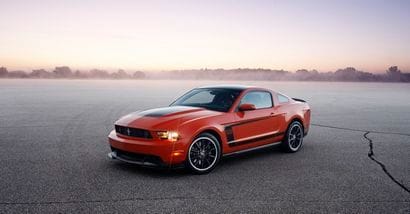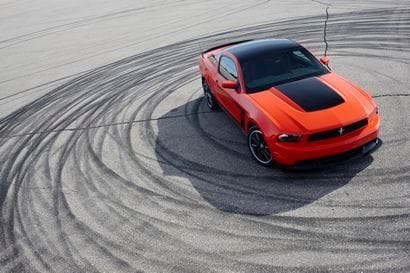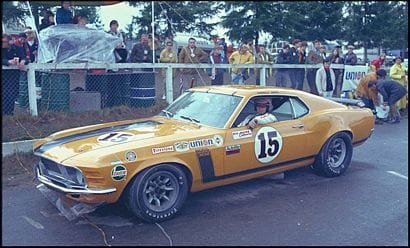Ford unveils the new 2012 Mustang Boss 302 at Monterey

Back to the future
The year was 1969. Barely five years after the first Mustangs had hit the streets, then-president of Ford, “Bunkie” Knudsen ordered Ford engineers to “build absolutely the best-handling street car available on the American market.” The result was the 1969 Mustang Boss 302.
Equipped with the company’s “Windsor” (denoting Ford’s Windsor, Ontario engine plant) small-block and a pair of reworked heads from the all-new 351 Cleveland engine, the four-bolt featured a forged crankshaft, connecting rods and pistons. To back up a claimed 290 gross horsepower (a conservative estimate, to say the least) Ford engineers stiffened up the chassis, added stiffer springs and shocks, dialed in special sway-bar tuning and added wider tires.
The result? The Boss 302 became the fastest Mustang, to that point, to ever lap the Ford test track.

How do you like me now?
Fast forward some forty plus years to the Monterey peninsula, site of the Laguna Seca race track and the site of the first-place finish of the Boss 302 at the opening race of the 1970 Trans-Am series where Ford today unveiled the new 2012 Ford Mustang Boss 302 as well as a track-ready limited-production Laguna Seca Package (more on that later).

Boss 302
“The team at Ford wanted to offer their fellow Mustang enthusiasts something really special – a beautifully balanced factory-built race car that they could drive on the street,” explains Dave Pericak, Mustang chief engineer. “The Boss 302 isn’t something a Mustang GT owner can buy all the parts for out of a catalog or that a tuner can get by adding a chip. This is a front-to-back re-engineered Mustang with every system designed to make a good driver great and a great driver even better.”
Upgrades from the 2011 Mustang GT include a new intake described as a “runners-in-the-box plenum/velocity stack combination.” Along with revised camshafts and engine calibration, they up the ante on GT’s 412 horsepower to 440, along with 380 lb.-ft. of torque.
All this power is channeled through a clutch with upgraded friction materials using a short-throw, close-ratio, six-speed manual tranny, while the 3.73 rear axle uses carbon fiber plates in the limited-slip diff to improve torque handling.
Other goodies include a quad exhaust system that features the traditional two-pipe rear exhaust, plus two outlets that “exit to either side of the exhaust crossover, sending exhaust through a set of metal discs that act as tuning elements before the pipes terminate just ahead of the rear wheel opening.”
The discs are removable and included are spacer plates sized to match aftermarket dump valves, while the side pipes, themselves, are tuned so that drivers can run all day at the track with them wide-open with sound levels that are, according to Ford, “comfortable” (ya think?).

Handling
Suspension mods include higher-rate coil springs with stiffer bushings and a larger rear stabilizer bar, with the chassis lowered 11 millimeters in front and 1 millimeter in back versus the GT. Shocks are adjustable to 5 settings with 1 as the softest and 2 the factory setting (adjustable by hand – a method similar to the Gabriel shocks found on the original 302).
Traction and stability control systems have been calibrated for maximum performance and both can be disabled, although there is an intermediate setting that permits even more aggressive driving before the systems intervene.
Tires are Pirelli PZeros with 255/40ZR-19s up front and 285/35ZR-19s in back. Brakes consist of the GT’s in back with an upgraded pad compound, while four-piston Brembos with 14-inch vented rotors complete the package in front.
The result of all this engineering is the first non-SVT Mustang to achieve more than 1.0 g of lateral acceleration and a 60-0 stopping distance that bests the GT’s available brake package by nearly three feet.

Exterior
To give the Boss 302 the proper new-millennium bad boy image, Ford massaged the design cues from both the ’69 Boss and the Bud Moore/Parnelli Jones race car. Available colors include orange, white, blue metallic, yellow metallic and red with a contrasting black or white roof panel, matching the color of the side “C” stripe.
A unique grill, fascia and splitter adorn the front, while a smaller lip spoiler adorns the trailing edge of the rear deck lid.
Interior
Inside, the Boss 302 features a dark metallic-finished instrument panel, door trim and gage cluster, black cue-ball shift knob and unique “Powered by Ford” door sill plates set it apart from more plebian Mustangs, while the removal of no less than 11 pounds of sound-deadening material brings drivers that much closer to what’s happening outside and under the hood.

We couldn’t have said it better
“Boss is a hallowed word around here, and we couldn’t put that name on a new Mustang until we were sure everything was in place to make this car a worthy successor,” explains Dave Pericak, Mustang chief engineer. “We were either going to do it right or not do it at all – no one on the team was going to let Boss become a sticker and wheel package.”
images courtesy of Ford Motor Company












